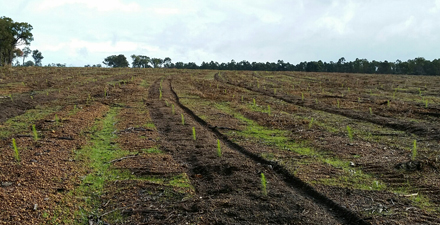
Pay decent rates and the forestry workers will come, a silviculture contractor says, as the industry struggles to attract staff to meet the New Zealand Government’s one billion trees program. Bay of Plenty silviculture contractor Simon Geddes said rates for those planting trees were not NZ$400 per day and workers were barely paid minimum wage. Source: Stuff NZ
The average worker planted 600 trees a day, receiving NZ18 cents to NZ25c per tree, Mr Geddes said.
“The highest I have paid a tree planter is NZ30c a tree, because of the rates we get from the forestry companies. The NZ50c to NZ60c a tree goes to the contractor.”
He said the solution to finding tree-planters was an increase in pay for everyone, and that industry wages failed to recognise the skill and work required for the job.
“In my opinion, the planter should be getting NZ40c to NZ50c a tree and the contractor more than NZ$1 a tree. Then we would not have a problem getting planters,” Mr Geddes said.
“It is quite a technical job and takes at least two years to get really good at it.”
He said the big forestry companies had put the screws on the industry to plant trees as cheaply as possible.
“A lot of Kiwis left the industry as it was no longer a good career option.”
Another silviculture contractor said, on average, his planters made NZ25c to NZ35c per tree, and planted anywhere from 800 to 1500 a day, depending on the conditions.
“It’s bloody hard work and even harder trying to find the right people that are willing to give it a go.”
Forest Industry Contractors Association chief executive Prue Younger said it was making efforts to improve employment conditions as well as pay rates for silviculture workers.
“The tide is turning. In my travels in the last six months, there has definitely been an improvement all round.”
But First Union general secretary Dennis Maga said the real reason for the worker shortage was poor company planning, unrealistic pay and work hours and some companies breaking the rules altogether.
He said planting was insecure work with minimal pay.
“There aren’t enough workers to plant the billion trees, because the jobs aren’t decent jobs. Pay the right rates and you’ll attract more workers.”
Silviculture workers earned less than NZ$35,000 a year on average.
The work was hard, with 6am starts, Mr Geddes said. But his business, Tane Mahuta, had its own “learn while you earn” training program.
“It’s a great job for people who like to be physically fit and outdoors, but they need to be rewarded for their efforts,” Mr Geddes said.
One of the major aims of the Government’s one billion trees program was to create employment opportunities, particularly in the regions.
As tree planting increases, the Government estimated the number of workers will need to nearly double by 2023, compared with 1000 now. This included workers in tree planting, nursery production, logistics and administrative support.
Pressure to provide workers for the one billion trees program should help to create better working conditions, Ms Younger said.
A report carried out by Coyne and Co Consultants last year for the association showed that 74% of contractors were experiencing major difficulties recruiting suitably skilled workers. The report said 88% of contractors believed shortages would get worse, as demand for services increased over the next three years.
Employment issues included staff not being paid for travel time from pick up to starting work and some silviculture contractors treating their staff as contractors rather than employees.
While some Government agencies considered tree planting a low-skilled job, this was untrue, Ms Younger said.
“Tree planters need to be highly skilled as they set the standard for the forest. It can be highly inefficient and unproductive if they do it wrong.”
As it would take time for New Zealanders to acquire the necessary skills, immigrants were needed to fill the gap, but forest workers were not on the Government’s essential skills list.
Forestry was competing with other jobs in construction, aged care, tourism and meat works, she said.
A spokesman for Regional Economic Development Minister Shane Jones said there would be challenges to meet the worker demand, but Te Uru Rakau (Forestry New Zealand) was working alongside industry and other agencies to ensure sufficient labour for the upcoming planting seasons.
This included providing opportunities for low-skilled workers to be work-ready for the planting season and offering information sessions for employers throughout the country.
“Work is already underway and partnership opportunities are being identified to support the 2019 planting season,” the spokesman said.





